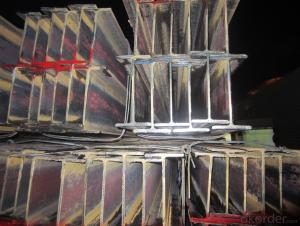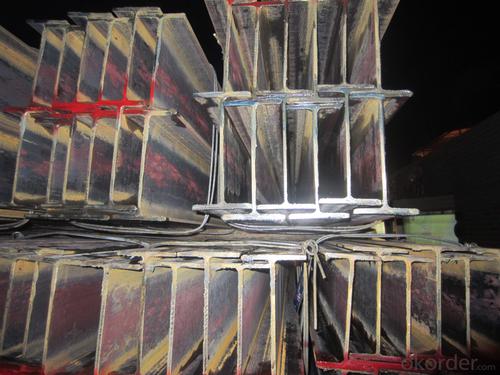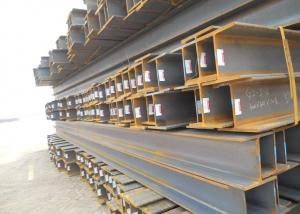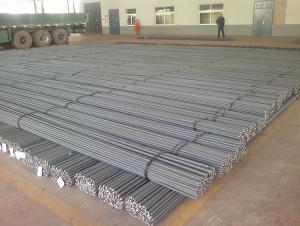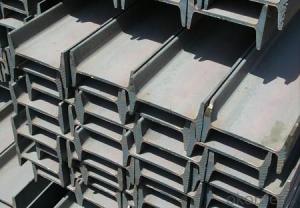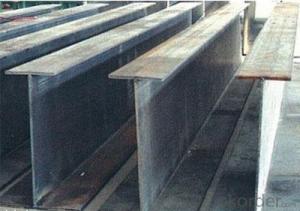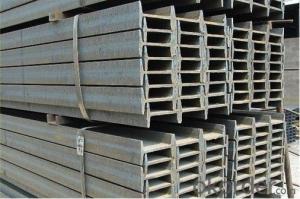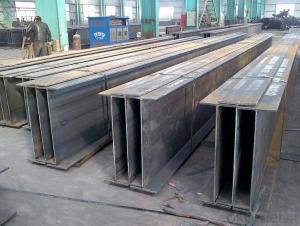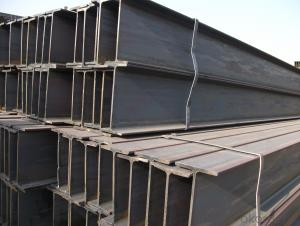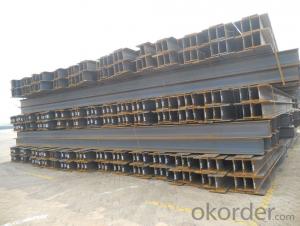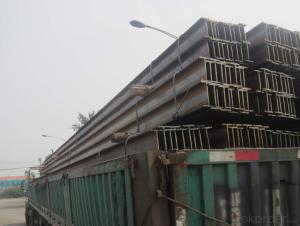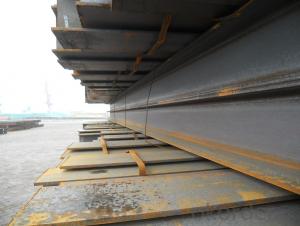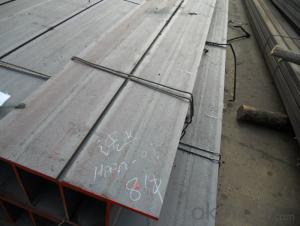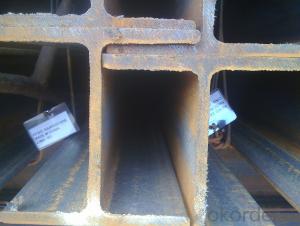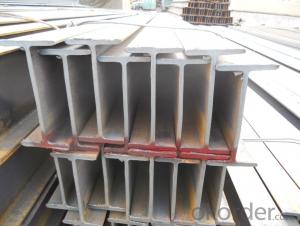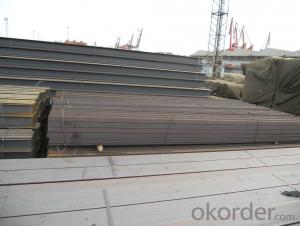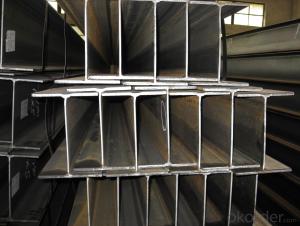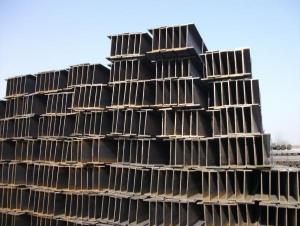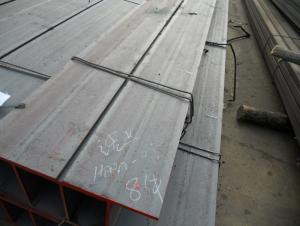High Quality Hot Rolled Steel Jis Standard H Beam
- Loading Port:
- Tianjin
- Payment Terms:
- TT OR LC
- Min Order Qty:
- 25 m.t.
- Supply Capability:
- 1000 m.t./month
OKorder Service Pledge
OKorder Financial Service
You Might Also Like
roduct Description:
Specifications of Hot Rolled Steel H-beam
1. Standard: GB
2. Grade: Q235 or Equivalent
3. Length: 6m,10m, 12m as following table
4. Invoicing on theoretical weight or actual weight as customer request
5.Payment: TT or L/C
6. Sizes:
Category | model (height*width)/ (mm×mm) | Section size/mm | Cross-section area/cm2 | Theoretical Weight/(kg/m) | Moment of inertia/cm4 | radius/cm | Section modulus/cm3 | |||||||
H | B | t1 | t2 | r | Ix | Iy | ix | iy | Wx | Wy | ||||
HW | 100×100 | 100 | 100 | 6 | 8 | 8 | 21.59 | 16.9 | 386 | 134 | 4.23 | 2.49 | 77.1 | 26.7 |
125×125 | 125 | 125 | 6.5 | 9 | 8 | 30.00 | 23.6 | 843 | 293 | 5.30 | 3.13 | 135 | 46.9 | |
150×150 | 150 | 150 | 7 | 10 | 8 | 39.65 | 31.1 | 1620 | 563 | 6.39 | 3.77 | 216 | 75.1 | |
175×175 | 175 | 175 | 7.5 | 11 | 13 | 51.43 | 40.4 | 2918 | 983 | 7.53 | 4.37 | 334 | 112 | |
200×200 | 200 | 200 | 8 | 12 | 13 | 63.53 | 49.9 | 4717 | 1601 | 8.62 | 5.02 | 472 | 160 | |
200 | 204 | 12 | 12 | 13 | 71.53 | 56.2 | 4984 | 1701 | 8.35 | 4.88 | 498 | 167 | ||
250×250 | 244 | 252 | 11 | 11 | 13 | 81.31 | 63.8 | 8573 | 2937 | 10.27 | 6.01 | 703 | 233 | |
250 | 250 | 9 | 14 | 13 | 91.43 | 71.8 | 10689 | 3648 | 10.81 | 6.32 | 855 | 292 | ||
250 | 255 | 14 | 14 | 13 | 103.93 | 81.6 | 11340 | 3875 | 10.45 | 6.11 | 907 | 304 | ||
HM | 150×100 | 148 | 100 | 6 | 9 | 8 | 26.35 | 20.7 | 995.3 | 150.3 | 6.15 | 2.39 | 134.5 | 30.1 |
200×150 | 194 | 150 | 6 | 9 | 8 | 38.11 | 29.9 | 2586 | 506.6 | 8.24 | 3.65 | 266.6 | 67.6 | |
250×175 | 244 | 175 | 7 | 11 | 13 | 55.49 | 43.6 | 5908 | 983.5 | 10.32 | 4.21 | 484.3 | 112.4 | |
HN | 100×50 | 100 | 50 | 5 | 7 | 8 | 11.85 | 9.3 | 191.0 | 14.7 | 4.02 | 1.11 | 38.2 | 5.9 |
125×60 | 125 | 60 | 6 | 8 | 8 | 16.69 | 13.1 | 407.7 | 29.1 | 4.94 | 1.32 | 65.2 | 9.7 | |
150×75 | 150 | 75 | 5 | 7 | 8 | 17.85 | 14.0 | 645.7 | 49.4 | 6.01 | 1.66 | 86.1 | 13.2 | |
175×90 | 175 | 90 | 5 | 8 | 8 | 22.90 | 18.0 | 1174 | 97.4 | 7.16 | 2.06 | 134.2 | 21.6 | |
200×100 | 198 | 99 | 4.5 | 7 | 8 | 22.69 | 17.8 | 1484 | 113.4 | 8.09 | 2.24 | 149.9 | 22.9 | |
200 | 100 | 5.5 | 8 | 8 | 26.67 | 20.9 | 1753 | 133.7 | 8.11 | 2.24 | 175.3 | 26.7 | ||
250×125 | 248 | 124 | 5 | 8 | 8 | 31.99 | 25.1 | 3346 | 254.5 | 10.23 | 2.82 | 269.8 | 41.1 | |
250 | 125 | 6 | 9 | 8 | 36.97 | 29.0 | 3868 | 293.5 | 10.23 | 2.82 | 309.4 | 47.0 | ||
300×150 | 298 | 149 | 5.5 | 8 | 13 | 40.80 | 32.0 | 5911 | 441.7 | 12.04 | 3.29 | 396.7 | 59.3 | |
300 | 150 | 6.5 | 9 | 13 | 46.78 | 36.7 | 6829 | 507.2 | 12.08 | 3.29 | 455.3 | 67.6 | ||
350×175 | 346 | 174 | 6 | 9 | 13 | 52.45 | 41.2 | 10456 | 791.1 | 14.12 | 3.88 | 604.4 | 90.9 | |
350 | 175 | 7 | 11 | 13 | 62.91 | 49.4 | 12980 | 983.8 | 14.36 | 3.95 | 741.7 | 112.4 | ||
400×150 | 400 | 150 | 8 | 13 | 13 | 70.37 | 55.2 | 17906 | 733.2 | 15.95 | 3.23 | 895.3 | 97.8 | |
HT | 100×50 | 95 | 48 | 3.2 | 4.5 | 8 | 7.62 | 6.0 | 109.7 | 8.4 | 3.79 | 1.05 | 23.1 | 3.5 |
97 | 49 | 4 | 5.5 | 8 | 9.38 | 7.4 | 141.8 | 10.9 | 3.89 | 1.08 | 29.2 | 4.4 | ||
100×100 | 96 | 99 | 4.5 | 6 | 8 | 16.21 | 12.7 | 272.7 | 97.1 | 4.10 | 2.45 | 56.8 | 19.6 | |
125×60 | 118 | 58 | 3.2 | 4.5 | 8 | 9.26 | 7.3 | 202.4 | 14.7 | 4.68 | 1.26 | 34.3 | 5.1 | |
120 | 59 | 4 | 5.5 | 8 | 11.40 | 8.9 | 259.7 | 18.9 | 4.77 | 1.29 | 43.3 | 6.4 | ||
125×125 | 119 | 123 | 4.5 | 6 | 8 | 20.12 | 15.8 | 523.6 | 186.2 | 5.10 | 3.04 | 88.0 | 30.3 | |
150×75 | 145 | 73 | 3.2 | 4.5 | 8 | 11.47 | 9.0 | 383.2 | 29.3 | 5.78 | 1.60 | 52.9 | 8.0 | |
147 | 74 | 4 | 5.5 | 8 | 14.13 | 11.1 | 488.0 | 37.3 | 5.88 | 1.62 | 66.4 | 10.1 | ||
150×100 | 139 | 97 | 4.5 | 4.5 | 8 | 13.44 | 10.5 | 447.3 | 68.5 | 5.77 | 2.26 | 64.4 | 14.1 | |
142 | 99 | 4.5 | 6 | 8 | 18.28 | 14.3 | 632.7 | 97.2 | 5.88 | 2.31 | 89.1 | 19.6 | ||
150×150 | 144 | 148 | 5 | 7 | 8 | 27.77 | 21.8 | 1070 | 378.4 | 6.21 | 3.69 | 148.6 | 51.1 | |
147 | 149 | 6 | 8.5 | 8 | 33.68 | 26.4 | 1338 | 468.9 | 6.30 | 3.73 | 182.1 | 62.9 | ||
175×90 | 168 | 88 | 3.2 | 4.5 | 8 | 13.56 | 10.6 | 619.6 | 51.2 | 6.76 | 1.94 | 73.8 | 11.6 | |
171 | 89 | 4 | 6 | 8 | 17.59 | 13.8 | 852.1 | 70.6 | 6.96 | 2.00 | 99.7 | 15.9 | ||
175×175 | 167 | 173 | 5 | 7 | 13 | 33.32 | 26.2 | 1731 | 604.5 | 7.21 | 4.26 | 207.2 | 69.9 | |
172 | 175 | 6.5 | 9.5 | 13 | 44.65 | 35.0 | 2466 | 849.2 | 7.43 | 4.36 | 286.8 | 97.1 | ||
200×100 | 193 | 98 | 3.2 | 4.5 | 8 | 15.26 | 12.0 | 921.0 | 70.7 | 7.77 | 2.15 | 95.4 | 14.4 | |
196 | 99 | 4 | 6 | 8 | 19.79 | 15.5 | 1260 | 97.2 | 7.98 | 2.22 | 128.6 | 19.6 | ||
200×150 | 188 | 149 | 4.5 | 6 | 8 | 26.35 | 20.7 | 1669 | 331.0 | 7.96 | 3.54 | 177.6 | 44.4 | |
Usage & Applications of Hot Rolled Steel H-beam
Commercial building structure ;Pre-engineered buildings; Machinery support structure; Prefabricated structure; Medium scale bridges; Ship-building structure. etc.
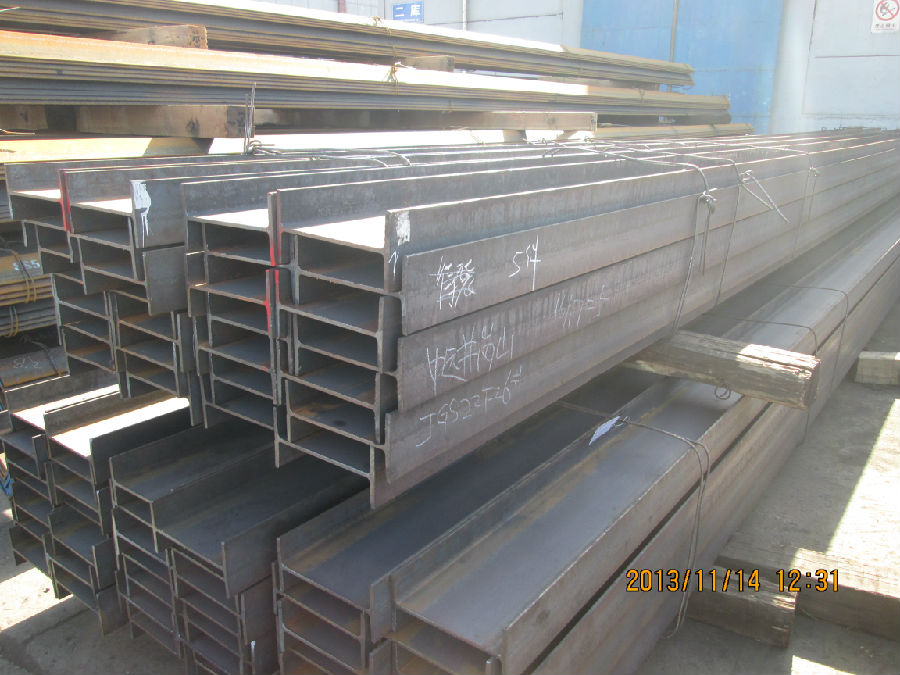
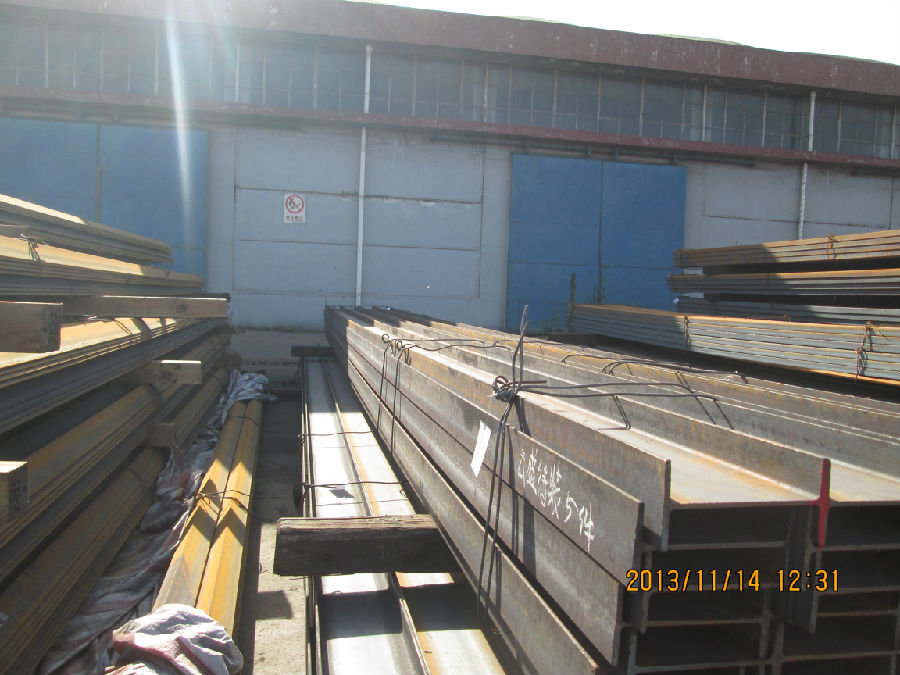
Packaging & Delivery of Hot Rolled Steel H-beam
1. Packing: it is nude packed in bundles by steel wire rod
2. Bundle weight: not more than 3.5MT for bulk vessel; less than 3 MT for container load
3. Marks:
Color marking: There will be color marking on both end of the bundle for the cargo delivered by bulk vessel. That makes it easily to distinguish at the destination port.
Tag mark: there will be tag mark tied up on the bundles. The information usually including supplier logo and name, product name, made in China, shipping marks and other information request by the customer.
If loading by container the marking is not needed, but we will prepare it as customer request.
4. Transportation: the goods are delivered by truck from mill to loading port, the maximum quantity can be loaded is around 40MTs by each truck. If the order quantity cannot reach the full truck loaded, the transportation cost per ton will be little higher than full load.
5. Delivered by container or bulk vessel
Production flow of Hot Rolled Steel H-beam
Material prepare (billet) —heat up—rough rolling—precision rolling—cooling—packing—storage and transportation
- Q: Can steel H-beams be used in utility infrastructure projects?
- Yes, steel H-beams can be used in utility infrastructure projects. They are commonly used in bridges, buildings, and other structures due to their strength, durability, and ability to support heavy loads. In utility projects, H-beams can be utilized for constructing support structures, such as transmission towers or substations, where strength and stability are crucial.
- Q: What are the common applications of steel H-beams?
- Steel H-beams have numerous common applications in the construction and engineering industries. They are widely used as structural supports in buildings, bridges, and infrastructure projects due to their high strength and load-bearing capacity. H-beams are also commonly utilized in the fabrication of heavy machinery, such as cranes and equipment frames, as well as in the construction of mezzanines, platforms, and industrial structures. Their versatility, durability, and ability to withstand heavy loads make steel H-beams a popular choice in various construction applications.
- Q: What is the maximum allowable camber for steel H-beams?
- The maximum allowable camber for steel H-beams is typically specified by the relevant industry standards or project specifications. The specific maximum allowable camber can vary depending on the size, grade, and intended use of the H-beam. It is important to consult these standards or specifications to determine the maximum allowable camber for a specific steel H-beam.
- Q: How do steel H-beams perform in wind-prone areas?
- Steel H-beams are extensively used in construction, particularly in areas susceptible to strong winds, as they are highly durable and robust. These beams have been specifically designed to withstand various forces, including wind loads, making them an ideal option for structures in wind-prone regions. The unique shape and design of H-beams allow them to possess superior load-bearing capacity and resistance to bending and twisting. Consequently, they are highly effective in enduring the forces exerted by high winds. The H shape of these beams provides a large surface area, enabling the even distribution of wind load across the structure, thereby reducing the risk of failure. Moreover, steel is renowned for its high strength-to-weight ratio, making H-beams a lightweight yet sturdy choice for areas prone to strong winds. This ensures that the overall integrity of the structure remains uncompromised, despite the dynamic and fluctuating forces exerted by strong winds. Additionally, steel H-beams exhibit excellent resistance to corrosion, a crucial characteristic in regions with high humidity or exposure to saltwater. These conditions can expedite the deterioration of other building materials, whereas steel H-beams remain unaffected, ensuring their longevity and structural integrity in wind-prone areas. Consequently, the need for frequent maintenance or replacement is minimized. To summarize, steel H-beams are an exceptional choice for wind-prone regions due to their high strength, load-bearing capacity, resistance to bending and twisting, and corrosion resistance. Their ability to endure wind loads and their durability make them a reliable option for constructing buildings and structures in regions characterized by strong winds.
- Q: How do steel H-beams perform in terms of creep resistance?
- The outstanding creep resistance of steel H-beams is widely recognized. Creep refers to the material's tendency to deform under constant stress over time. Steel H-beams are designed specifically to bear high levels of stress and maintain their structural integrity for extended periods. The H shape, combined with the properties of steel, endows these beams with exceptional resistance to creep. The H shape enhances strength and rigidity, enabling the beam to evenly distribute the load and prevent localized deformation. Moreover, steel itself is a highly durable material renowned for its remarkable creep resistance. Steel H-beams find extensive use in construction projects demanding long-term stability and load-bearing capacity. They are commonly employed in the construction of bridges, high-rise buildings, and industrial structures. The ability of steel H-beams to withstand creep ensures that these structures can endure constant stress over many years. It is worth noting that while steel H-beams generally exhibit excellent creep resistance, their specific performance can vary depending on factors such as the grade of steel used, the loading conditions, and the environmental factors present. Nonetheless, steel H-beams are generally regarded as a reliable and durable choice for applications that require crucial creep resistance.
- Q: Can steel H-beams be used for soundproofing walls?
- No, steel H-beams cannot be used for soundproofing walls. While steel H-beams are commonly used in construction for their strength and load-bearing capabilities, they do not possess soundproofing properties. Soundproofing requires materials that can absorb or block sound waves, such as acoustical insulation, dense materials like concrete, or specialized soundproofing panels. Steel H-beams, being primarily structural components, do not offer such soundproofing characteristics. To effectively soundproof walls, it is recommended to use specific soundproofing materials and techniques designed for that purpose.
- Q: Can steel H-beams be used in railway platforms?
- Certainly, railway platforms can utilize steel H-beams. Steel H-beams find widespread application in construction endeavours owing to their remarkable endurance, robustness, and adaptability. They offer outstanding structural reinforcement and possess the ability to bear substantial burdens, thereby making them fitting for railway platforms. Additionally, steel H-beams can be effortlessly crafted and set up, enabling expedient and economical construction. All in all, steel H-beams prove to be a trustworthy option for railway platforms, ensuring steadfastness and security for both passengers and trains.
- Q: Can steel H-beams be used for supporting shipyard structures?
- Indeed, shipyard structures can indeed be supported by steel H-beams. Due to their remarkable strength and capacity for bearing heavy loads, steel H-beams are widely employed in construction. They are especially well-suited for the support of weighty structures typically found in shipyards. The H-shaped design of these beams ensures superb structural stability and enables the efficient dispersal of the load. Furthermore, steel possesses exceptional durability, enabling it to withstand the harsh marine environments commonly encountered in shipyard settings. Consequently, steel proves to be an optimal material choice for shipyard structures.
- Q: How do steel H-beams perform in extreme temperature conditions?
- The exceptional performance of steel H-beams in extreme temperature conditions is well-known. This is due to the inherent properties of steel, such as its high melting point and thermal conductivity. As a result, steel H-beams are able to withstand extreme temperatures without experiencing significant deformation or structural failure. In environments with high temperatures, steel H-beams maintain their strength and stability, ensuring the integrity of the structure they support. This makes them suitable for use in industrial furnaces, boilers, and other facilities that operate at high temperatures. Moreover, steel H-beams also perform effectively in low-temperature conditions. Unlike other materials, steel does not become brittle in extreme cold. It retains its toughness and resilience, allowing it to withstand freezing temperatures without compromising its structural integrity. Furthermore, steel H-beams have a low coefficient of thermal expansion, meaning they expand and contract minimally with changes in temperature. This characteristic helps prevent warping or buckling, which is particularly important in structures that are exposed to frequent fluctuations in temperature. Overall, steel H-beams demonstrate exceptional performance in extreme temperature conditions, making them a reliable choice for a wide range of applications where temperature variations are a concern.
- Q: Can steel H-beams be used for sports arenas or stadiums?
- Indeed, sports arenas or stadiums can utilize steel H-beams. These beams are frequently employed in the construction sector owing to their robustness and adaptability. They furnish exceptional structural support, rendering them appropriate for extensive undertakings such as sports arenas or stadiums. The beam's H shape permits an augmented load-bearing capacity, making it an optimal choice for enduring the weight of a stadium's roof, seating sections, and other infrastructure. Moreover, steel H-beams are renowned for their endurance and resilience against environmental elements like weather and seismic activity, which establishes them as a dependable selection for enduring sports facilities.
Send your message to us
High Quality Hot Rolled Steel Jis Standard H Beam
- Loading Port:
- Tianjin
- Payment Terms:
- TT OR LC
- Min Order Qty:
- 25 m.t.
- Supply Capability:
- 1000 m.t./month
OKorder Service Pledge
OKorder Financial Service
Similar products
Hot products
Hot Searches
Related keywords
